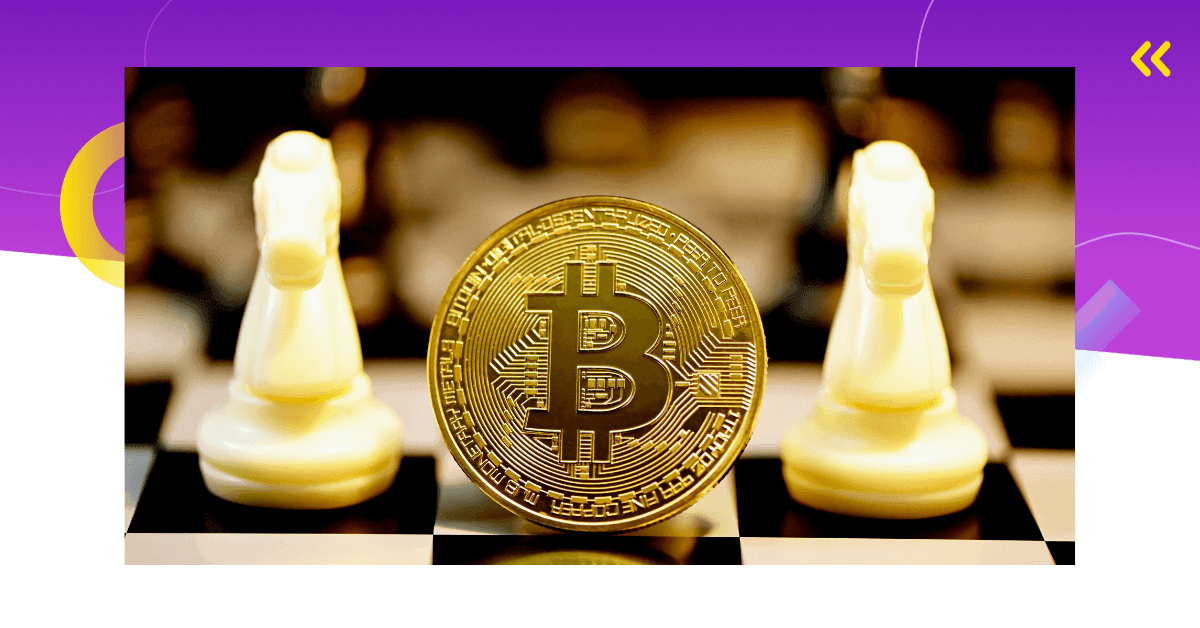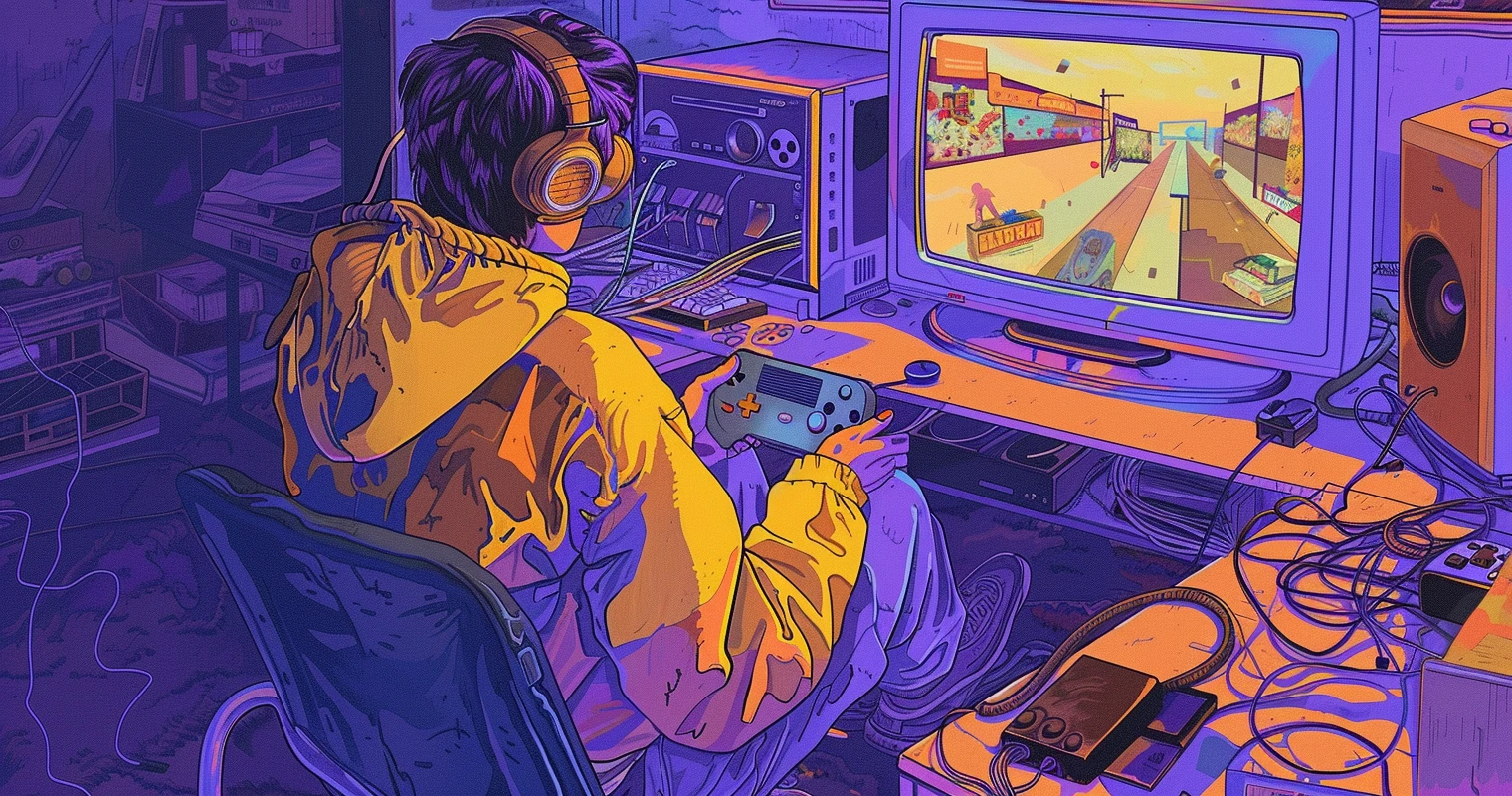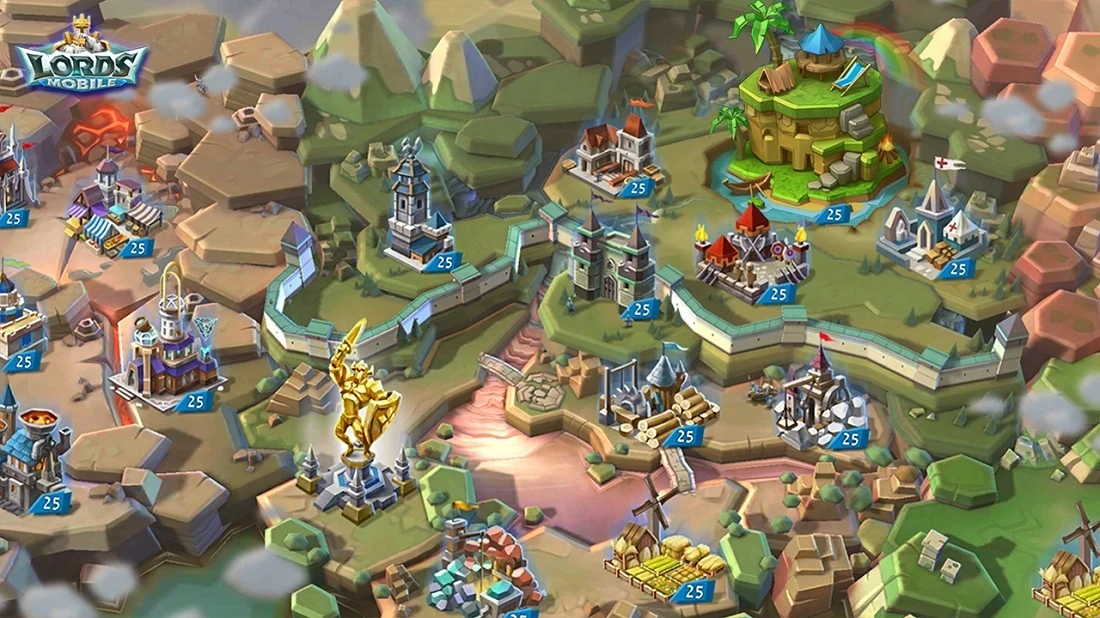Blockchain gaming seems complicated to you? Looking for an article to explain it in a simple manner?
You’ve come to the right place.
In this article, we’re bringing you the basics of blockchain gaming. You’ll find out how it works, what it has to do with cryptocurrencies, and much more.
Since our focus is mobile games, we’ll put a special emphasis on how it affects the mobile game market.
Let’s get started.
What Is Blockchain?
Before diving into blockchain gaming, you need to understand the concept of blockchain.
By definition, blockchain is a decentralized set of data blocks managed by a global network of computers. These data blocks are linked together using cryptography. With the help of cryptography, they can record information, typically transactions.
Once a piece of information has been recorded, it is impossible to edit or delete it. Plus, the network’s transaction history is publicly available.
Something like a web-based notary.
Blockchain became a well-known term thanks to its relation to cryptocurrencies. Today, everyone seems to be investing in them.
Cryptocurrencies are digital currencies that are created within blockchain technology. The main role of blockchain is to keep track of how their values vary. Thanks to blockchain, everyone’s aware of when Bitcoin, Ethereum, and others go up and down.

What Are Blockchain Games?
Blockchain has created new opportunities for virtual economies – including game economies. It became an alternative monetization route in gaming.
The alternative to what?
Traditional, centralized games. In these games, the developer controls all items, currency, and collectibles distribution.
In blockchain gaming, things are different.
Unlike traditional games, blockchain games are decentralized. Rather than living on a centrally controlled server, blockchain game assets are dispersed among players.
These assets have their value, and they are based on blockchain technology. The two most common blockchain elements in these games are cryptocurrencies and non-fungible tokens (NFTs).
How Blockchain Gaming Works: Cryptocurrencies and NFTs
A lot of games based on blockchain gaming are called crypto-something, Bitcoin-something, etc.
This is because the main selling point for these games is the possibility of earning cryptocurrency.
In blockchain games, cryptocurrencies are used for in-platform payments. In them, players own in-game assets that they can exchange for cryptocurrency and real-life money.
NFTs are a bit more difficult to understand.
A non-fungible token is a unique data unit stored on a blockchain. The term “non-fungible” means that it’s unique and cannot be replaced.
For example, a Bitcoin and a dollar bill are fungible.
You can trade a dollar for another dollar with someone, and you’ll both have an equally valuable thing. However, if you trade NFTs, the situation is different because their values differ.
NFTs can come in different forms. For example, digital images, music, cards, skins, etc. They represent any type of digital asset ownership.
In blockchain games, players can earn or purchase NFTs. Once they do this, this asset is all theirs, and it has its own in-game value. From the moment they receive an NFT reward, players gain full ownership of these assets.
NFT assets are not only valuable in-game but also in external marketplaces where they can be traded or sold.

Blockchain Gaming Terms You Need to Know
In order to really understand blockchain gaming, you need to understand the terms and concepts that occur around it.
Here are some of them.
Play-To-Earn Games
Just like their name suggests, play-to-earn games allow players to earn rewards by playing them.
Before the blockchain era, these rewards were mainly money and sponsor packs.
Today, when someone mentions play-to-earn games, they probably talk about blockchain-based games.
For example, in NFT-based games, players can earn different in-game assets. Those can be skins, weapons, currency, or something else, depending on the game. These assets are the players’ compensation for playing and being engaged in the game.
These assets have their value, and players decide how to handle them.
On the other hand, crypto-based games reward players for playing the game in small amounts of cryptocurrency. The money-making process in these games is usually long and slow-paced, but the cashouts are real.
Some players take play-to-earn games very seriously. These games are especially popular in developing countries where players perceive them as a significant source of income.
Here’s what a mother of three from the Philippines said about one of these games for CNBC, “What matters is having money so we can eat, avoid debts and get through every day. It (the game) sustained our daily needs, paid our bills, and debts.”

Pay-To-Earn Games
In pay-to-earn games, players need to make an upfront purchase of an in-game asset. For the most part, this concept applies to NFT-based games.
However, this only covers the “pay” part of the term. The “earn” potential of these games lies in the value of in-game assets the players have purchased.
The thing is, the value of these assets can grow over time. Players have the power to make strategic decisions to gain the most from their value.
They can keep playing and upgrade them to increase their value, or they can get rid of them as early as possible.
If they want, they can transfer the assets outside the game and sell them to other people without the game developer knowing.
GameFi
The term GameFi is a blend of two words – “gaming” and “decentralized finance”.
Essentially, the term describes the intersection between these two areas. It refers to the financialization of gaming on the blockchain network.
Decentralized finance is also known as DeFi. This umbrella term describes different financial services that take place on the blockchain. For example, popular crypto apps like Coinbase or Crypto.com are frequently referred to as DeFi apps.
On the other hand, GameFi describes all types of games that allow players to profit by playing them. This includes both pay-to-earn and play-to-earn games.

Metaverse Games
Lately, the term metaverse has been getting a lot of traction. Especially since Facebook has changed its name to Meta.
Utterly simplified, the metaverse is a name for the digital space where people can connect in all sorts of areas. This space includes things like digital services, augmented reality, virtual reality, gaming, video, etc.
Basically, the metaverse promises to bring a greater overlap of people’s digital and physical lives.
Some say that all things based on blockchain technology belong to the metaverse, including blockchain games. In fact, certain media outlets are already calling these games “metaverse games”.
 It All Started with CryptoKitties
It All Started with CryptoKitties
In 2017, this online game revolutionized the gaming world. CryptoKitties was the first widely recognized blockchain game.
In it, players could own, breed, and exchange kitties, the only asset in the game.
This game falls into the pay-to-earn category. In order to even join the game, players first needed to purchase the Ethereum cryptocurrency.
Once they had this currency, players could buy themselves a virtual pet that is actually an NFT. The pets were available for sale in virtual auctions filled with offers from other players.
Every pet carried its own number and different DNA attributes. Each of them was 100% unique and 100% owned by the player who has it.
To increase their value, players could breed their pets with others. This would create new offspring with mixed DNAs and a brand new NFT to auction. The rarer their attributes were, the more value they would hold.
Basically, these virtual cats were static images that could be purchased, bred, and sold. The game itself had no other goal.
During the time the game was popular, some of these NFTs reached crazy values. In fact, one of the kitties was sold for $172,000 (Cnet). Thanks to this transaction, this game made headlines.

Axie Infinity Took Over
Axie Infinity is another game that includes digital pets. Launched in 2018, this online game has become the most popular blockchain game ever and remains so today.
How did it manage to remain on the top for so long?
Let’s go over how it works.
This game is populated by Axies, digital pets. Players can collect, breed, exchange pets, and use them for in-game battles.
Does this remind you of another game? Many describe this game as the “Pokémon on the blockchain”.

The main difference between the two? Axie Infinity is a pay-to-play-to-earn game. Axies are actually unique digital objects (NFTs) stored on the game’s own blockchain.
To start playing the game, players need to purchase at least three Axies. They can be bought in the game’s marketplace. To do this, players need to have some Ethereum cryptocurrency in their digital wallets.
The game includes two types of tokens – AXS (Axie Infinity Shards) and SLP (Smooth Love Potion). Think of them as two in-game currencies.
AXS works as a governance currency. The players that own it can vote on in-game changes. This makes it appealing for players who crave power and in-game democracy.
On the other hand, SLP is something similar to hard currency. Players can earn it by completing challenges or battling. The currency has its own value, and it can be sold to other players. Besides this, players can use it for breeding and upgrading their Axies.
Essentially, players can sell three assets from this game – SLPs, AXS, or Axies. By doing this, they can earn different amounts of cryptocurrency.
However, Axie Infinity’s popularity has dropped in 2022 – it lost as many as 40% of its users since Q1 2022. That was the result of the Ronin hack and SLP depreciation. However, while UAWs reached the lowest point in May 2022, they started increasing once again in June 2022 (DappRadar)
Learn about top blockchain games by UAW (unique active wallets) in the following section.
Top Blockchain Games of Q2 2022 by UAW
Data source: DappRadar
Here are the top blockchain games of Q2 2022 according to daily average unique active wallets.
- Splinterlands (283k)
- Alien Worlds (188k)
- Farmers World (124k)
- Upland (45k)
- Axie Infinity (33k)
- Second Live (30k)
- Gameta (19k)
- MOBOX: NFT Farmer (19k)
- MiningNetwork (16k)
- Pegaxy (16k)

Blockchain Gamers (Statistics)
Here’s more info about how gamers view blockchain games and how interested they are in the concept.
Data source: Newzoo & Crypto.com research.
Respondents: 4,569 (across three major blockchain gaming markets – the United States, the United Kingdom, and Indonesia).
- 13% of respondents have played blockchain games in the past and 5% are currently playing. 40% have an interest in playing. 22% of respondents have no interest in playing blockchain games. Others were confused about the prospect of blockchain gaming or never heard of it.
- When we look at all gamers, the gender distribution is very equal. However, blockchain gamers lean towards men (60% are men and 40% are women).
- The majority of blockchain gamers are Millennials and Gen Z.
- The majority of blockchain gamers have mid-to-high-income levels.
- Blockchain gamers are the most likely to play the following game genres: adventure, fighting, shooter, battle royale, and arcade.
- The main reasons why blockchain gamers spend money on games are unlocking extra content, leveling up a character, personalizing a character, gaining an advantage, special offers, investing, and speeding up progress.
- The main reasons why blockchain gamers don’t spend on games are overly expensive content, the game is fun without extra content, items can be acquired by grinding, investment is required too early, not sure how long they’ll play, no bundle offers, and a lack of customization options.
- Here’s why blockchain gamers play blockchain games: to earn a bit extra on the side (34%), grow crypto assets (30%), build an NFT collection (24%), because it’s fun (23%), explore virtual worlds (20%), make a living out of a hobby (17%), collect items (15%), customize avatars (15%), and socialize (13%).

State of Blockchain Gaming on Mobile
Blockchain gaming has been around for a couple of years already. For the most part, successful blockchain titles were online games.
You’re probably wondering – how come mobile games aren’t leading the way? Aren’t they more popular than online games?
Fair questions.
The thing is, there are plenty of blockchain mobile games out there. However, there still hasn’t been a breakthrough mobile game to take the throne.
The reason?
None of these games has managed to solve the main issues that come with blockchain mobile gaming. Some of these issues are scalability and speed.
For this reason, major mobile game developers are working hard on developing quality infrastructure before getting into the business.
Let’s take a look at how blockchain works in mobile games right now.
Blockchain and Mobile Game Economies
All mobile game developers have the same goal – creating profitable in-game economies.
Today, these economies are fueled by in-app purchases. If players want to access premium content or progress faster, they can use real money to buy something from the game. They can either buy these assets directly or use another asset – in-game currency.
In blockchain mobile games, all in-game assets are “tokenized”.
Think of it like this.
What used to be currencies are now tokens. To understand this better, you can think of them as physical, tangible tokens. They exist in the game, players own them, and they are in their wallets.
These tokens are based on a blockchain network, which grants them their own value, not just the traditional value of an in-game currency.
This leaves developers with a lot of design options. Some games have one token, others have multiple, etc.
In traditional mobile game economies, the players don’t really own anything. They merely get the chance to rent some of the studio’s belongings. However, in the concept of blockchain gaming, the players own in-game assets, which changes the power dynamic.
IAPs vs. Crypto-Based Mobile Games
Whenever a mobile gamer makes an in-game purchase, the app stores take a slice of the pie. Just like that, the developers lose 15% or 30% of each transaction.
More and more developers are trying to find ways around this. For example, launching their games on new app stores that take smaller cuts.
In crypto-based games, this issue doesn’t exist.
Since crypto is the payment method here, there is no need for Google or Apple to process the transactions. We have yet to see how the app stores will handle this issue.
However, another middleman will take a share of developers’ revenues – the blockchain platforms. How will that work? How much will they take? We’ll let you know when the platforms roll out.
How Blockchain Games Run on Mobile
Getting started with blockchain mobile games is quite a process.
Besides downloading a blockchain game, players also need to install a mobile blockchain wallet. In it, they can store all their owned digital assets.
Right now, players need to download these wallets through the app stores. This is one of the things that is offputting for mobile gamers.
There is too much hassle involved.
Mobile gamers are used to having everything in one place, and they expect nothing less from blockchain games.

Benefits of Blockchain Gaming for Developers
Developers wouldn’t be developing blockchain games if there weren’t some significant benefits.
Let’s take a look at a couple of these advantages.
Growing Market
One of the challenges for blockchain mobile game developers is that there are no prominent market leaders.
At the same time, this is beneficial for them.
The thing is, market leaders have the ability to popularize the whole market segment. Just like Candy Crush Saga popularized match-3 games, for example.
When such a game appears – many pioneer blockchain games on the market will be rewarded. This will boost the players’ interest in the overall blockchain gaming market, and existing titles will gain new traction.
Moreover, all developers on the market can benefit from the fact that this market is growing. Whether it’s an indie developer or a big studio, they all have the chance to create a hit blockchain game.
Super-Engaged Playerbases
Blockchain players perceive these games quite differently than players of traditional games.
Due to the nature of blockchain games, these players take these games quite seriously.
These are definitely not casual players looking to kill time.
Typically, blockchain gamers are very devoted to these games and put a lot of time and effort into them. In the case of pay-to-earn games, they also invest money into them. All of this creates additional opportunities for developers to profit from their players.
Creative Ways to Make a Profit
In IAP-based games, developers want to make players addicted and spend a lot of money.
To achieve this, they frequently rely on aggressive monetization techniques.
With blockchain games, developers can utilize more innovative ways to make money. Instead of thinking about the assets’ prices, they need to think about the creative value of these assets.
While designing in-game assets, developers need to think about how their values will increase in the future. For example, in Cryptokitties, this was done by delivering a large number of DNA attributes to the “kittie” NFTs.
From the players’ perception, this doesn’t seem like an aggressive, money-grabbing strategy.
These games are set up, so the profits are distributed between the players and the developers. For this reason, players perceive them as something that will help them make money, not just take it away from them.

Benefits of Blockchain Gaming for Players
When it comes to blockchain gaming, a lot of the benefits go into the players’ favor.
Here are some of them.
Real Digital Ownership
When gamers earn something in a blockchain game, that digital asset is in their ownership.
No one can take it away from them, even if the game shuts down forever. The thing is, these assets are tied to players, not games.
In traditional games, players frequently experience buyer’s remorse. This happens when players invest money and effort into a game, but the game keeps asking for more. This way, the game devalues their previous purchases, and players feel cheated.
In blockchain games, this problem doesn’t exist. For this reason, players feel different about the money they spend on such games.
Full Control
In blockchain games, players have complete control over their digital accounts and assets.
They know they can trade, sell or gift their owned assets as they please. They also have the freedom to interact with the game’s economies any way they want to.
If they want to use them in competitors’ games, they can do that too.
The thing is, in-game assets are no longer limited by narrow game economies. Since in-game assets are represented by digital tokens, they can be traded freely. Basically, players can use them in any market that works on the blockchain technology.
Players Make the Rules
Traditional games are centralized. This means that the studios are in total control, and they make the rules for players. There is not much room for democracy.
In blockchain gaming, things are different.
In these games, players actually get a vote. If the majority, even just 51% of players, vote something should change in the game, the developer will be forced to make the change.
To make this possible, many games introduce “governance” tokens that give players decision-making power.
The thing is, as long as a blockchain game is popular enough, it will stay alive. A game only dies when its players leave it, not when developers decide to shut it down.

Challenges of Blockchain Gaming
Whenever there is an innovative concept, not everything can or will run smoothly.
A couple of things are holding back the widespread adoption of blockchain games.
The main issue blockchain developers face is something called the blockchain trilemma.
This term refers to a triangle of decentralization, scalability, and security. Naturally, developers want to have all three in their games.
However, at the moment, they can’t.
Right now, they can only pick two out of three. If the game is decentralized and fast, it won’t be as secure. On the other hand, if it is decentralized and secure, it may not be as fast as they want it to be.
Scalability refers to how many transactions the system can handle without slowing down. For this reason, it is commonly referred to as speed.
Traditionally, game economies work fast and seamlessly. However, since economies based on Bitcoin and Ethereum are decentralized, they work slower than centralized networks.
The first successful blockchain game, CryptoKitties, had a major issue with this. At one point, the number of player transactions pushed the Ethereum network to the verge of scalability. This happened with about 100,000 users at the time.
What can we then expect from games with millions of users? We’re looking forward to seeing how developers will overcome these obstacles.

Discussing the Future of Blockchain Gaming on Mobile
Blockchain gaming is still a young concept, and we don’t understand it to the fullest.
However, many mobile gaming experts agree – blockchain games are the future of the industry.
Yet, almost no one dares to predict how this future will look exactly. Here’s what we believe will happen in the near future.
One thing will happen for sure – the blockchain gaming experiences will get better.
Blockchain platforms in development have already announced they will solve the biggest problems with blockchain gaming.
For example, they plan on introducing white-label wallets. This should lower the entry barrier for playing blockchain games.
Features like that should make the gamers’ experiences seamless and more similar to what they are used to.
Moreover, as big mobile game studios start rolling out blockchain features, fewer people will perceive these games as scams. As this happens, more and more mobile gamers will accept the concept of blockchain games.
Some developers will create in-game economies that are entirely based on cryptocurrencies.
However, we believe that most developers will introduce some blockchain gaming features and make them optional. This way, players will be able to choose versions of the game they feel most comfortable with.
Blockchain Gaming Wrap Up
Hopefully, this article has helped you understand what blockchain gaming is all about.
Have any thoughts, input, or questions? Feel free to leave us a comment below!







Comments